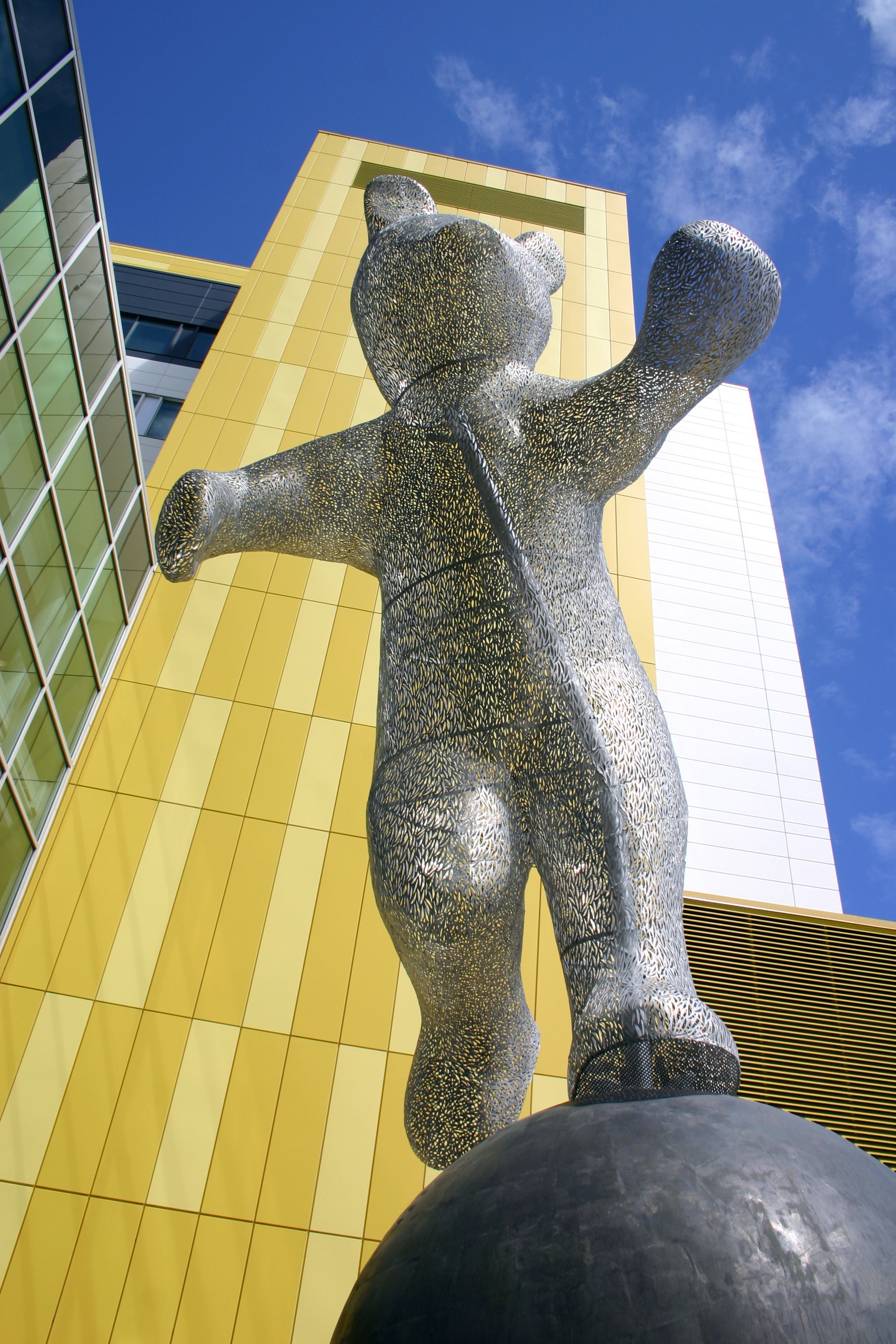Montreal and public art, a feature story to be published in three parts.
Public art seems to bring out a lot of negative opinions in our province. So why does the government keep on investing in it?
“You’re not photographing this! It’s fucking ugly,” says a construction worker to artist Michel Saulnier, as he takes a picture of one of his public artworks: a larger-than-life bear, installed right outside the Children’s Hospital at the McGill University Health Centre.
According to the Bureau d’art public, there are more than 315 works of public art displayed around the city of Montreal, and they often elicit strong reactions — be they good or bad. In Suzanne Guy’s documentary on public art in Quebec, À Tout Hasard, artist Jean-Robert Drouillard recalls a moment when a teenage girl saw his life-sized dancer sculpture. “It’s not going to stay here,” she said to the artist, thinking he was a construction worker installing it. People are often shocked when made to look at contemporary art. “A [lesson of] at least notions on how to look at a piece of art, would be needed,” said Pascal Beaudet, project manager at the Ministry of Culture and Communications.
In the summer of 2015, the city of Montreal unveiled La Vélocité des Lieux, a work of public art by collective BGL on the corner of Henri-Bourassa and Pie-IX boulevards. Many people used the launch of this particular piece to express their discontentment with public art. In a Journal de Montréal story announcing the launch of the work, 133 people commented online, and very few had positive opinions. Many questioned why money was spent on public art, considering there were so many cuts to governmental services like health and education. “It’s ugly, too expensive and useless,” said one citizen in the comments. Even if one of the goals of public art is to, among other things, make art more accessible, negative opinions seem to hold more weight for those in the arts.
Why does the government keep investing in public art?
Public art, according to the Canadian Encyclopaedia, is commissioned for a public space where the composition, dimensions and proportions blend into the surroundings. “It’s a way of being directly in contact with art without having to make an effort,” said Beaudet.
When Saulnier was working on his bear cub statue on the MUHC site, a piece named Je suis là, he experienced first-hand the reactions of having his works of art on display at a public site. Construction workers passing by stopped to comment on how they had asked for more materials and were refused, but that the government paid for an illuminated bear cub. Why is it that healthcare is being subjected to so many cuts, but the government has money for art, some would ask? For Saulnier, those reactions reflect a lack of understanding of the one per cent decree.
The Quebec policy of Integration of Art to Architecture, also known as the one per cent decree, was first established in 1961. With some modifications over the years, it has resulted in an obligation to spend approximately one per cent of the building’s total construction budget on public art. This policy applies to all buildings that receive grants from the government.
The decree promotes art creation and acquisition, advertises the works of Quebec’s artists and allows people all over the province to have access to contemporary art, according to Art Public Montréal.
The process of integrating art into architecture is complex. Beaudet said the integration starts with a file, a sort of bank, which gathers artists according to categories. Professional artists join the file on a voluntary basis, and then two members of the ministry and two visual arts specialists review their applications. There are many requirements that must be met in order to join the file: the artist needs to have Canadian citizenship, to have been living in Quebec for at least 12 months and to have professional artist status. Then, when a building receives a grant, a project manager will go through the construction project to create a committee that will establish the type of artwork to include based on the place and what would appeal to the people that occupy it. A few artists from the file will then be invited to propose a project.
While the ministry takes care of the art in the whole province, the Montreal Public Art Bureau, created in 1989, is responsible for all public art within the city. Laurent Vernet, commissioner of the bureau, said the one per cent decree is managed in Montreal by the bureau, following the ministry process. They also take care of the investments made by the city of Montreal outside of the policy.
Some projects are not included in the one per cent decree, but still receive investments from the city of Montreal. That was the case for La Vélocité des Lieux. The bureau needs to review those investments, making sure they are pertinent and fit correctly within the overall environment of the city. Since investment projects don’t have a predetermined budget, unlike those who qualify under the one per cent decree, the bureau works with comparable projects. Usually, the allotted budget will be of about one or two per cent of the total cost of the building.
This article is part of a long-form feature on public art that will be presented in three parts. Stay tuned for part two, which will appear in our Nov. 15 issue.




